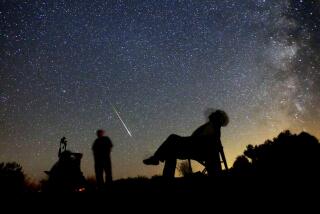Force of Comet Impact Amazes Astronomers
The collision of a rogue comet and Jupiter is quickly unfolding as a fierce and sobering celestial cataclysm, astronomers around the world reported Sunday.
The Keck Telescope in Hawaii captured images of two comet fragments exploding into giant, gaseous fireballs hotter than the surface of the sun. The Hubble Space Telescope photographed a 2,500-mile-wide mushroom cloud erupting hundreds of miles into space from a detonation more powerful than any nuclear weapon on Earth.
“We are all flabbergasted at what we are seeing,” said planetary scientist Heidi B. Hammel, who is leading the team of scientists gathered in Maryland to analyze the images taken by NASA’s space telescope. “We can be very glad that this comet was heading for Jupiter and not Earth.”
It is the first time humanity has seen a comet hit a planet, although many planetary experts believe that Earth--like the other planets in the solar system--has been hit thousands, if not millions, of times in eons past.
By late Sunday, seven clumps of comet debris had smashed into Jupiter at speeds in excess of 130,000 m.p.h. Another 14 major pieces of the shattered comet Shoemaker-Levy 9 are expected to hit by Friday. At least four of the fragments nearing the planet are believed to be about two miles in diameter.
The smallest fragment to hit so far--a half-mile-wide ball of compacted ice and rock that struck Jupiter on Saturday--released so much explosive energy that on Earth it would vaporize a city the size of Los Angeles in an instant, comet scientists said. At the same time, it would hurl enough dust and debris into the upper atmosphere to dangerously disrupt the world’s climate, they said.
Scientists and astronomers estimated the force of its impact at 10 million megatons of TNT. It left a spreading plume of hot gas and debris almost as big as Earth itself.
“If that had hit North America, it would probably be the worst natural disaster ever witnessed by man, and that’s from the small fragment,” said Eugene Shoemaker, co-discoverer of the comet.
One of the largest pieces, with a mass about 25 times greater, was expected to strike Jupiter early this morning. More than 200 major observatories were poised to record the results.
“This is the World Cup of astronomy,” said Stephen P. Maran, a senior scientist at NASA’s Goddard Space Flight Center in Maryland, which is coordinating reports on the collision.
All of the impacts occur on Jupiter’s dark side, out of direct view of Earth. Therefore, almost nothing of the comet’s violent interplay with Jupiter is visible to the naked eye or with the small telescopes used by many amateur comet watchers. Very little of the celestial fireworks is visible under normal light.
Professional astronomers are relying on the artificial eyes that science has given them, discerning the true extent of the cataclysm by peering deep into the infrared and ultraviolet wavelengths as the impact sites rotate out of shadow and into view of Earth.
Unlike the infrared photographs, conventional pictures of Jupiter taken through major telescopes this weekend show the impact sites as dark smears or splotches against the giant planet’s candy-striped bands of ammonia clouds.
Scientists speculated Sunday that the dark material could be a fountain of dust and debris rocketing skyward from the disintegrating comet fragment. Others suggested it could be gases stirred up from deep within Jupiter’s atmosphere.
But to the infrared sensors of the Keck, the Hubble and other telescopes, which are sensitive to the heat generated by each impact, the plumes stand out as white-hot blazes. Hammel said the temperature of the swirling gases at the center of each fireball could top 53,000 degrees Fahrenheit.
Glenn Orton, a scientist from Pasadena’s Jet Propulsion Laboratory who is observing the impacts through NASA’s Infrared Telescope Facility in Hawaii, easily detected two of the impact sites. “I am very ecstatic,” he said Sunday. “Witnessing this is kind of amazing.”
Astronomers at the South Pole observatory, which because of its unique location is able to keep Jupiter under continuous observation during the collisions, reported that they easily detected the plume from the first fragment that struck the planet.
From its site atop Mauna Kea on the island of Hawaii, the Keck Telescope was expected to have the best view of the severe impact expected about 12:30 a.m. today. The Keck is the largest of the world’s ground-based telescopes and was the only observatory Sunday to report having observed any traces of the second comet fragment, which hit Jupiter on Saturday evening.
“We saw a distinctive signature of the plume,” said James Graham, an astronomer from UC Berkeley who is a principal investigator at the W. M. Keck Observatory. “It surprises us how bright these impacts are.”
Astronomers suspect that the second fragment may have been fainter than the first because it might have been a more loosely compacted swarm of gravel and ice crystals--a flying rubble pile--that exploded high above Jupiter’s clouds.
“The first and second fragments looked equally big prior to the impact,” said Maran at his base in Maryland. “The difference in the impacts might have been the difference between a real hard-packed snowball a nasty adult makes and the kind of loosely packed snowball a kid makes.”
Initial observations suggest that the clouds spreading from each impact site may persist for weeks. “It looks pretty clear that this whole band of latitude around Jupiter will be pock-marked with these impact sites,” Hammel said.
One of the most dramatic photo sequences recorded by the Hubble Space Telescope this weekend was a series of five images taken by its Wide Field/Planetary Camera, designed and built by JPL engineers, that shows the growth of a mushroom cloud from the first impact. The images were taken at three-minute intervals as the impact site rotated out of the dark side of Jupiter.
They profile the explosion as it erupted more than 600 miles above the planet’s highest cloud layer, and “this knocked our socks off,” Hammel said.
Unconfirmed reports from observatories in Israel and western Massachusetts suggested that observers had been able to spot the lightning-like flash from at least one of the impacts, flaring near the planet’s horizon.
“It means that other flashes could be visible to people with small telescopes,” said David H. Levy, who helped discover the comet in March, 1993. “This is a red alert for amateur astronomers.”
* Times Link: 808-8463
To commemorate humankind’s first steps on the moon 25 years ago this Wednesday, TimesLink features historic audio clips beginning in 1961 with President John F. Kennedy declaring the goal of landing a man on the moon, as well as other lunar anniversary features. To hear any of these clips, call TimesLink and press * and the four-digit code for the category you want to hear. Kennedy’s moon speech: *6200 Launch of Apollo 11: *6201 Life aboard Apollo 11: *6202 Space news update: *6203 Astronaut’s horoscopes: *6204 The Eagle lands on moon: *6205 Problems landing on moon: *6206 “That’s one small step...”: *6207 Aldrin’s first step: *6208 Nixon phones astronauts: *6209 Unveiling lunar plaque: *6210 Armstrong shoots photos: *6211 Collecting lunar samples: *6212 Lunar blast-off: *6213 Splashdown and recovery: *6214 World events, July, 1969: *6220 Pop music of July, 1969: *6221 Aldrin anniversary speech: *6222 Call TimesLink from area codes 213, 310, 714, 818 or 909. From other regions, use the area code nearest you.






